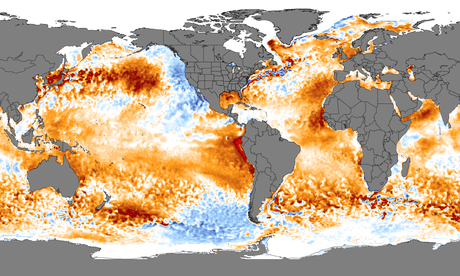Extract from The Guardian

Climate researchers say magnitude of predicted weather event uncertain but if an extreme El Niño occurs ‘we’ll need to buckle up’
Wed 12 Apr 2023 01.00 AEST
Last modified on Wed 12 Apr 2023 01.49 AESTSome models are raising the possibility later this year of an extreme, or “Super El Niño”, that is marked by very high temperatures in a central region of the Pacific around the equator.
The last extreme El Niño in 2016 helped push global temperatures to the highest on record, underpinned by human-caused global heating that sparked floods, droughts and disease outbreaks.
Australia’s Bureau of Meteorology said in a Tuesday update that all seven models it had surveyed – including those from weather agencies in the UK, Japan and the US – showed sea surface temperatures passing the El Niño threshold by August.
But the bureau and climate scientists warned that forecasts were much less reliable during the southern hemisphere autumn and outlooks should be “viewed with some caution”.
There was a 50% chance of an El Niño developing before the end of the year, the bureau said.
A feature of El Niños is a rise in sea surface temperatures at least 0.8C above the long term average in a region of the central equatorial Pacific. Extreme El Niños feature temperatures in that region of 2C above average.
Several of the forecasts suggest temperatures could get this high by October, but scientists again urged caution with the results.
Dr Mike McPhaden, a senior research scientist at the US National Oceanic and Atmospheric Administration, said historically El Niños tended to come along every four years or so.
“We’re due one. However, the magnitude of the predicted El Niños shows a very large spread, everything from blockbuster to wimp,” he said.
He said big El Niños tended to come along every 10 to 15 years and so it would be “very unusual” to see one so soon on the heels of the last major one in 2015 and 16.
“Even so, nature has a way of tripping us up just when we think we know it all,” he said.
“The really big ones reverberate all over the planet with extreme droughts, floods, heatwaves, and storms. If it happens, we’ll need to buckle up. It could also fizzle out. We should be watchful and prepared either way.”
Catherine Ganter, a climatologist at the bureau, said: “It’s a tricky time of year to forecast, but we do see consistency amongst international climate models of warming towards El Niño levels.”
The bureau was also monitoring temperatures in the Indian Ocean, where there was a “slightly increased risk” of conditions developing that tend to cause drier conditions to the south-east and central parts of the country, amplifying the effects of El Niño.
She said for Australia, the strength of an El Niño didn’t necessarily line up with the strength of the impacts. But she said: “During El Niño, you tend to see decreased rainfall across eastern Australia during winter and spring and we also see above-average daytime temperatures across the southern two-thirds of the country.”
Those conditions increased the risk of bushfires and heatwaves, she said.
Studies have suggested that as global heating continues, the chances of the world experiencing extreme El Niño events also goes up. In Australia, El Niños increase the risk of droughts, heatwaves and bushfires in the east of the country and, for the Great Barrier Reef, raises the prospects of mass coral bleaching.
Globally, previous El Niños have pushed up global average temperatures to record levels and have been linked with floods and landslides in Central America, droughts in South America and failed or delayed monsoon in India. The strongest El Niño this century, from 2015 to 2016, was linked with outbreaks of disease around the globe, including cholera and dengue fever.
As a note of caution, McPhaden and other scientists have pointed to 2014 when there were early predictions of a strong El Niños that did not materialise. But the strongest El Niño this century did begin the year after, said Dr Agus Santoso, a University of New South Wales expert on the climate shifts in the Pacific.
He said since observations became more reliable in the 1950s, there had only been three extreme El Niños – 1982 to 83, 1997 to 98, and 2015 to 16. Some scientists also considered a 1972 to 1973 El Niño as an extreme event.
Santoso said: “The predictions are tipped towards El Niño, but if it’s going to be a weak or strong one … we’ll have to wait a while longer.”
He said “we still have to be considering” the prospects of an extreme El Niño, but there would be much more confidence in the models by June.

No comments:
Post a Comment